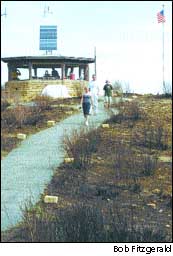|
August 15, 2000
By Janelle Holden Journal Staff Writer As visitors flocked back to Mesa Verde National Park on Monday, crews had to scramble to remove mud from the roadsides. Over the weekend, 1.13 inches of rain fell in the park, causing some minor mud slides over the main access road. The National Weather Service is predicting more rain for this week, which could add to the park’s troubles. The Burned Area Emergency Rehabilitation Team, which has been studying ways to rehabilitate the park, is worried that a wet summer could erode and move backcountry cultural sites downslope with the mud. Earl C. Ruby, a hydrologist on the team, reported that this weekend’s rain caused mud to flow down the Morefield Canyon into the park’s wastewater lagoons. These were recently rebuilt at a cost of more than $225,000. Ruby estimated that they could be destroyed if similar mud flows continue to bring sediment down into the canyon. The Bircher and Pony fires burned more than 20,000 acres in the 52,000 acre park, and although the work is beginning on the rehabilitation efforts, they could take years to complete. "We’ve included some site treatments for some specific sites in the front country, and what we’ve done is for erosion control is we’re going to be doing aerial seeding," said Hal Luedtke, a BAER team leader. The team will also recommend that the park begin laying excelsior on the soil above the sites to slow down rainwater flowing off the hill. The excelsior is a 4-foot-by-180-foot roll of aspen shavings that acts as a mat and a deterrent to water runoff. The BAER team will be publishing its assessments from the Pony Fire on Friday, but Luedtke said there are many more individual assessments that need to be completed during the rehabilitation efforts. After the BAER team’s results and funding recommendations are approved, the park will set up an implementation team to begin the on-the-ground work. Luedtke said there are 1,400 known archaeological sites within the burned areas of the Pony and Bircher fires. He estimates that about 90 sites could be worked on initially, but the park needs to have experts look at each site. "The bulk of this plan is the protection of cultural resource sites," he said. If the BAER team’s recommended funding is approved, the park will be receiving $1,934,141, including money for damages caused by fire suppression. The BAER team is also recommending that the park come up with an additional $1,913,854 to complete the rehabilitation. Funds will also go to the Ute Mountain Ute Reservation and BLM for needed repairs. Wetherill Mesa, which hosts several frontcountry ancient Puebloan kivas, pueblos, and pithouses, was burned over by the Pony Fire. Luedtke said that they will be recommending that the park close some sites on Wetherill Mesa to visitors until the sites are stabilized. Their main concern is that heat from the fire will cause rock to fall off in and around the sites. Two footbridges and several safety signs were also burned in the area. Long House suffered some damage and is of particular concern to the BAER team. The Pony and Bircher fires were extremely hot, and almost 90 percent of the acres involved were severely burned. Fire could still smolder within the roots systems of site trees, leaving empty pipes for rain water that could damage subsurface ruins. The process is slow, and whether the park can implement the recommendations before more rains continue to erode the park is a concern. "All we can do is move as fast as we can," Luedtke said. Mesa Verde Superintendent Larry Wiese said Monday morning he is planning to have Wetherill Mesa open through much of September (Wetherill normally is closed after Labor Day). For the cost of a Long House tour ticket ($1.75), visitors will be able to get an interpretive tour of the Pony Fire burn area along the tram road, as well as the cliff-dwelling tour. |
||
|
Copyright © 2000 the Cortez
Journal. All rights reserved. |
